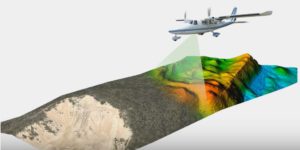NEWS
Due to the current outbreak of COVID-19, we believe that many of you might have experience in working from home. Our committee members have also conducted VC meetings to process the Institute’s operation, through computers or smart devices. We do wish everyone be safe and keeps healthy.
Making use of smart device (like iPad) in the VC meeting, we would like to introduce you some latest available technologies behind and the possibility of BIM applications.
Apple has announced its latest iPad Pro, which equips the most advanced configurations (including powerful chips, ultra-wide camera, and even a LiDAR Scanner!!!).
Equipped with the A12Z Bionic chip, the new iPad Pro is faster and more powerful than many PC. With the powerful graphic processor, it means it can conduct the modelling tasks more performance and realism (i.e. Augmented reality (AR)).
The new iPad Pro features a very impressive camera system: –
With the second camera, it doubles the possibilities of photo and video. For examples, enabling different perspectives and multi-camera use, which provides multi-information in modelling.
Yes! The newest iPad Pro even equips LiDAR technology, which is commonly adopted in surveying / construction industry (i.e. aerial survey, topographic survey or underground survey).
The breakthrough LiDAR Scanner equipped in the newest iPad Pro enables capabilities on any mobile device that brings LiDAR to the consumer market. But of course, we shall study deeply for the actual accuracy for a precise modelling. The custom designed LiDAR Scanner measures the reflected light distance to surrounding objects up to 5 metres away, both indoors and outdoors. It operates at the photon level, operates at nano-second speeds.

(Video refers to “All About Lidar, The Laser-Shooting Wonder Box That Could Make Self-Driving Cars Real”, by the Wired)
LiDAR is the useful technology for building a 3D map of the sensor’s surrounding. It uses light pulses to measure distances and locations in a similar way that radar uses radio signals. Yet, LiDAR sees in much greater details than radar, it can make the cars capable enough to drive without that constant supervision.
New depth frameworks in iPadOS combine depth points measured by the LiDAR sensor with data from both cameras and motion sensors. The result is then enhanced by computer vision algorithms on the A12Z Bionic chip for a more detailed understanding of a scene. The tight integration of these elements enables a whole new class of Augmented reality (AR) experiences on the iPad Pro.
AR apps become even more realistic. Placing an AR object now happens instantly. Realistic object occlusion allows AR objects to pass in front of and behind real-world structures. Improved motion capture and people occlusion are more accurate than ever. And developers will be able to create even more immersive experiences.
AR apps automatically get the instant AR placement. Realistic object occlusion allows AR objects to pass in front of and behind real-world structures. Improved motion capture and people occlusion are more accurate. Developers can harness this scanning technology to create more immersive experiences, with the latest update to ARKit with a new scene geometry API. (For more, please browse following [Link] )
The breakthrough LiDAR scanner delivers depth-sensing capabilities. It reveals more specialized workflows and supports professional grade photo and videos in combination with the ultra-wide camera and studio-quality microphones.
The LiDAR scanner improves the Measure app, making it easier and faster to calculate someone’s height automatically. Meanwhile, helpful vertical and edge guides appear automatically to let users measure objects more quickly and accurately. The Measure app now also comes with Ruler View for more granular measurements and allows users to save a list of all measurements, complete with screenshots for future use.
According to the Verge reports, “alongside the AR version of Hot Lava, Apple also showed some other impressive uses of the Lidar scanner to journalists over a briefing earlier today. One, for the CAD app Shapr3D, scans a room and makes a 3D model of the room in the app. Users can then edit that model to add new objects into the room and look at those additions in the real room using AR.”
According to the Wired, the LiDAR Scanner on the newest iPad Pro was actually not solely designed for the iPad. However, “Yes, LiDAR is well suited for that kind of work. “There are a lot of benefits for AR applications. You need to know where the physical objects are in order to place virtual objects on top,” says Gordon Wetzstein, who heads up Stanford University’s Computational Imaging Lab. “It helps you to understand the environment around you, and understand where’s the floor, where’s the table, where’s the chair, where do I put my Pokémon on these visual objects. That’s something that really requires precise depth definition from the mobile device, ideally with low power and low latency.”
The latest iPad Pro with LiDAR marks a major milestone, since democratizing the LiDAR has been a topic of considerable debate for some time. Undoubtedly, the newest iPad with LiDAR technology puts Apple at the pole position to bring LiDAR to the masses. It is likely that more Apple’s 2020 higher-end iPhone 12 models, or smart-devices from other brand will be supporting the LiDAR technology as well.
Become CBIM member to enjoy member-only access to resources, connections and support!
Not a member? Join HKICBIM

Hong Kong Institute of Civil and Building Information Management (HKICBIM) is a newly formed institute which provides an informative platform for civil and building counterparts to network and exchange civil Building Information Modeling (BIM) knowledge. HKICBIM aims to foster technological innovation and accelerate the adoption of Civil and Building Information Modeling Management in the Architecture, Engineering, Construction (AEC) industry.
The Articles and By-Laws set out the HKICBIM objectives of establishment, grades of membership, structure and management, professional conduct, and other rules relevant to conduct the affairs of HKICBIM. In addition, the By-Laws may be revised and supplemented periodically as and when necessary.